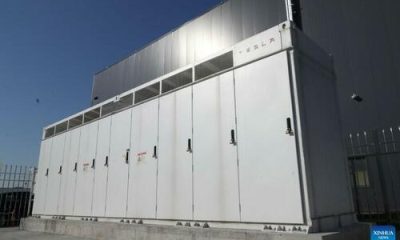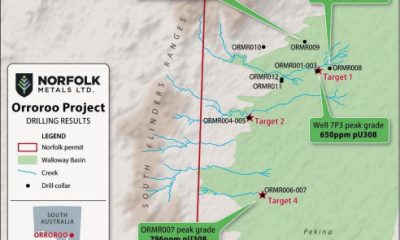Energy & Critical Metals
Are Small Nuclear Reactors The Answer To Big-Tech’s Energy Crisis?
Are Small Nuclear Reactors The Answer To Big-Tech’s Energy Crisis?
Authored by Felicity Bradstock via OilPrice.com,
Microsoft hints at…
Are Small Nuclear Reactors The Answer To Big-Tech’s Energy Crisis?
Authored by Felicity Bradstock via OilPrice.com,
-
Microsoft hints at its nuclear plans by posting a job for a “Principal Program Manager Nuclear Technology” to explore integrating SMRs into its operations.
-
Small Nuclear Reactors offer quick deployment, reduced costs, and enhanced safety features, with over 80 designs under global development.
-
Challenges like sourcing materials for SMR development, particularly from politically complex regions, may delay their commercial rollout.
Microsoft could be the first of several companies to prepare to use small nuclear reactor (SMR) technology for its high energy consumption, as AI and other technologies become more widely used. There has been great enthusiasm around the potential of SMRs, which could be built faster and at a much lower cost than a traditional nuclear reactor. This month, Microsoft posted a job opportunity for a “Principal Program Manager Nuclear Technology,” suggesting its interest in using SMRs in the future, to support its energy-intensive operations. As companies begin to use a vast range of digital technologies in their day-to-day operations, their energy consumption could increase substantially, making the use of low-carbon nuclear power increasingly attractive.
SMRs are advanced nuclear reactors that have a power capacity of up to 300 MW(e) per unit, equivalent to around one-third the generating capacity of a traditional nuclear reactor. SMRs are much smaller than traditional reactors and are modular, making it simpler for them to be assembled in factories and transported to site. Because of their smaller size, it is possible to install an SMR on sites that are not suitable for bigger reactors. They are also significantly cheaper and faster to build than conventional nuclear reactors and can be constructed incrementally to meet the growing energy demand of a site.
There are strong safety margins included in SMR production, meaning that the potential for the unsafe release of radioactivity to the environment is significantly reduced. These systems can be shut down automatically, without human assistance, in the case of a malfunction. At present, there are over 80 commercial SMR designs under development worldwide, aimed at responding to a range of needs. Although companies are still trepidatious about investing in SMRs as their economic competitiveness in use has yet to be proven. As energy companies begin to roll out SMRs within the next decade there will be a greater understanding of their applicability and the costs involved.
Despite still being in the development stage, Microsoft appears to be one of the first companies to demonstrate its interest in SMRs. As companies continue to digitalise operations and conduct high-energy operations, they will need an increasing amount of energy to power their activities. For example, AI researchers suggest that training a “single large language deep learning model” such as OpenAI’s GPT-4 creates around 300 tonnes of CO2. The average person is responsible for creating around 5 tonnes of CO2 a year, showing just how significant this is.
Microsoft now appears to be drawing up a roadmap for the use of SMR to power its computation needs. This month, the company posted a job description to hire a nuclear technology expert to lead the company’s technical assessment for integrating small modular nuclear reactors and microreactors “to power the datacentres that the Microsoft Cloud and AI reside on.” The post reads that Microsoft is seeking a “principal program manager for nuclear technology”, who “will be responsible for maturing and implementing a global Small Modular Reactor (SMR) and microreactor energy strategy.”
This is not the first time the tech giant has shown interest in nuclear power. In May, Microsoft signed a power purchase agreement with Helion, a nuclear fusion start-up, to purchase electricity from it starting in 2028. And Bill Gates, Microsoft’s co-founder, is the chairman of the board of Terrapower, a company that is currently developing SMR technology. Although there has been no suggestion that Terrapower will provide Microsoft with any nuclear reactors.
Microsoft is showing an early interest in integrating nuclear power into operations. But, as more companies are using energy-intensive technologies, they will require vast amounts of energy to power their activities. Meanwhile, governments worldwide are putting increasing pressure on companies to decarbonise operations, with some introducing carbon taxes and others encouraging the use of clean energy sources through financial incentives. Renewable energy sources, such as wind and solar power, can take years to develop, and acquiring a stable clean energy source also means investment in battery technology. However, as the use of SMRs becomes more commonplace, their fast manufacturing time and small land footprint will likely appeal to companies looking for alternative clean energy sources.
Despite the optimism around SMR technology, a commercial rollout is likely still a long way off due to recent difficulties in acquiring the materials needed to develop these reactors. Many SMRs under production at present will run on uranium at enrichments as high as 15 to 19.75 percent, known as high-assay low-enriched uranium (HALEU). However, this is currently only commercially available from Russia, with which many governments and private companies have cut ties following the Russian invasion of Ukraine last year. Chris Levesque, the CEO of TerraPower, explained “It has become clear that domestic and allied HALEU manufacturing options will not reach commercial capacity in time to meet the proposed 2028 in-service date for the Natrium demonstration plant.”
There has been a rise in the popularity of SMR technology, thanks to its small size and relatively low-cost and fast manufacturing potential. While the commercial rollout of SMRs is still far off, it could provide the vast amounts of low-carbon energy required to meet the world’s growing electricity needs. And tech companies, such as Microsoft, will likely be some of the first to invest in SMR technology as they look to meet their rising computation needs while striving to decarbonise operations.
Tyler Durden
Mon, 10/02/2023 – 13:00
uranium
renewable

Uranium Exploration Company Announces Additional Staking in the Athabasca Basin
Source: Streetwise Reports 12/22/2023
Skyharbour Resources Ltd. announced an update from its Canada-based Falcon Project along with additional…
Tesla Launches New Mega Factory Project In Shanghai, Designed To Manufacture 10,000 Megapacks Per Year
Tesla Launches New Mega Factory Project In Shanghai, Designed To Manufacture 10,000 Megapacks Per Year
Tesla has launched a new mega factory…
Giving thanks and taking stock after “a remarkable year”
An end-of-year thank you to our readers, industry colleagues and advertisers before Electric Autonomy breaks from publishing until Jan. 2
The post Giving…

















